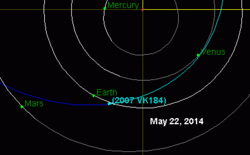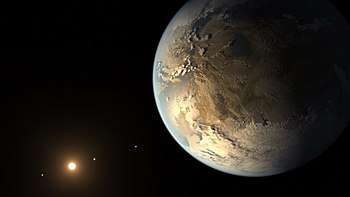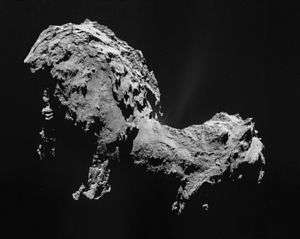2007 VK184
2007 VK184 is a sub-kilometer asteroid, classified as a near-Earth object of the Apollo group, and estimated to be approximately 130 meters (430 ft) in diameter.[4] It was listed on the Sentry Risk Table with a Torino Scale rating of 1.[4] A Torino scale rating of 1 is a routine discovery in which a pass near the Earth is predicted that poses no unusual level of danger.[5]
 The 2014 close approach of 2007 VK184[1] | |
| Discovery[2] | |
|---|---|
| Discovered by | Catalina Sky Survey (703) |
| Discovery date | 12 November 2007 |
| Designations | |
| Orbital characteristics[3] | |
| Epoch 23 May 2014 (JD 2456800.5)[3] | |
| Uncertainty parameter 1[3] | |
| Aphelion | 2.7104 AU |
| Perihelion | 0.74227 AU |
| 1.7263 AU | |
| Eccentricity | 0.57003 |
| 828.49 d (2.27 yr) | |
Average orbital speed | 15.6 km/s |
| 338.50° | |
| Inclination | 1.2225° |
| 253.96° | |
| 73.159° | |
| Physical characteristics | |
Mean diameter | ~130 meters (430 ft)[4] |
| Mass | 3.3×109 kg (assumed)[4] |
| 22.0[3] | |
Description
2007 VK184 was discovered on 12 November 2007 by the Catalina Sky Survey.[2] It was recovered on 26 March 2014 by Mauna Kea,[6][7] and removed from the Sentry Risk Table on 28 March 2014.[8] By 4 January 2008, with an observation arc of 52 days, there was a 1 in 2700 chance of an impact with Earth on 3 June 2048.[9] The Sentry Risk Table, using an observation arc of 60 days, showed the asteroid had a 1 in 1820 chance (0.055%) of impacting Earth on 3 June 2048.[4] Since the March 2014 recovery, it is known that the asteroid will pass 0.013 AU (1,900,000 km; 1,200,000 mi) from Earth on 2 June 2048.[1]
2014 passage
Before the 2014 close approach, the asteroid had a modest observation arc of 60 days,[4] and the imprecise trajectory of this asteroid was complicated by close approaches to Earth, Venus and Mars.[1] On 23 May 2014, the asteroid passed 0.17 AU (25,000,000 km; 16,000,000 mi) from Earth[1] and reached an apparent magnitude of ~20.8.[10] As expected the close approach allowed astronomers to recover the asteroid on 26 March 2014 and refine the odds of a future collision.[7] As the asteroid gets closer to Earth, the positional uncertainty becomes larger.[11] By recovering the asteroid well before closest approach you can avoid searching a larger region of the sky.[11] Most asteroids rated 1 on the Torino Scale are later downgraded to 0 after more observations come in.
Risk assessments were calculated based on a diameter of 130 meters.[4] It was estimated that, if it were ever to impact Earth, it would enter the atmosphere at a speed of 19.2 km/s and would have a kinetic energy equivalent to 150 megatons of TNT.[4] Assuming the target surface is sedimentary rock, the asteroid would impact the ground with the equivalent of 40 megatons of TNT and create a 2.1 kilometers (1.3 mi) impact crater.[12] Asteroids of approximately 130 meters in diameter are expected to impact Earth once every 11000 years or so.[12]
On 26–27 March 2014, additional observations were made which ruled out the chance of an impact in 2048.[11]
See also
- 99942 Apophis, a NEO that, for a few days, was thought to have a slight probability of striking the Earth in 2029. But the likelihood that would happen was quickly determined to be zero.
References
- "JPL Close-Approach Data: (2007 VK184)" (last observation: 2014-03-27; arc: 6.37 years). Retrieved 1 April 2014.
- "MPEC 2007-V94 : 2007 VK184". IAU Minor Planet Center. 13 November 2007. Retrieved 27 October 2010.
- "JPL Small-Body Database Browser: (2007 VK184)" (last observation: 2014-03-27; arc: 6.37 years). Jet Propulsion Laboratory. Retrieved 1 April 2014.
- "2007 VK184 Earth Impact Risk Summary". Wayback Machine:NASA/JPL Near-Earth Object Program Office. 17 October 2013. Archived from the original on 17 October 2013. Retrieved 1 April 2014.
- "The Torino Impact Hazard Scale". NASA/JPL Near-Earth Object Program Office. 13 April 2005. Retrieved 5 November 2011.
- "MPEC 2014-F50 : 2007 VK184". IAU Minor Planet Center. 28 March 2014. Retrieved 1 April 2014.
- "2007 VK184 Orbit". IAU Minor Planet Center. Retrieved 1 April 2014.
- "Date/Time Removed". NASA/JPL Near-Earth Object Program Office. Retrieved 1 April 2014.
- "WayBack Machine archive from 10 Jan 2008". Wayback Machine. 10 January 2008. Archived from the original on 10 January 2008. Retrieved 20 February 2013.
- "2012 VK184 Ephemerides for 23 May 2014". NEODyS (Near Earth Objects – Dynamic Site). Retrieved 21 February 2013.
- "Asteroid 2007 VK184 Eliminated as Impact Risk to Earth". NASA/JPL Near-Earth Object Program Office. 2 April 2014. Archived from the original on 8 November 2015. Retrieved 3 April 2014.
- Robert Marcus; H. Jay Melosh & Gareth Collins (2010). "Earth Impact Effects Program". Imperial College London / Purdue University. Retrieved 20 February 2013. (solution using 130 meters, 2600 kg/m3, 19.2 km/s, 45 degrees, target: sedimentary rock)


